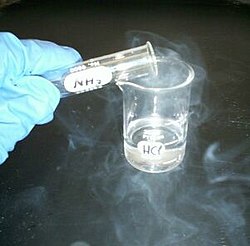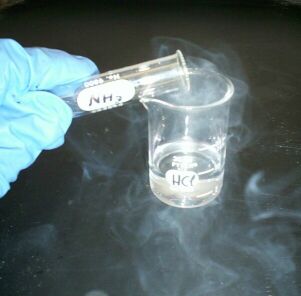Base (chemistry)
chemical substance that can react with an acid, accepting hydrogen ions (protons) or more generally, donating a pair of valence electrons From Wikipedia, the free encyclopedia
Remove ads
A base is a substance that can accept a hydrogen ion (H+) from another substance. A chemical can accept a proton if it has a negative charge, or if the molecule has an electronegative atom like oxygen, nitrogen, or chlorine that is rich in electrons. Like acids, some bases are strong and others are weak. The weak bases are less likely to accept protons, while the strong bases quickly take protons in solution or from other molecules. An acid is a base's "chemical opposite". An acid is a substance that will donate a hydrogen atom to the base.

Bases have a pH greater than 7.0. Weak bases generally have a pH value of 7–9 while strong bases have a pH value of 9–14.
Remove ads
How bases work
Bases react with acids. This reaction makes a weaker acid and weaker base, called the conjugates.
In water, strong bases make hydroxide ions. The hydroxide takes a hydrogen ion from an acid. This makes a water molecule, which is neutral (it is the same as the solvent). The other parts of the acid and the counterion from the base are attracted together to make neutral salts. Because adding the base to the acid makes its pH more neutral, this is called neutralization.
Weak bases react without making hydroxide. For example, ammonia (NH3) is a weak base that dissolves in water but does not react. When a strong acid like hydrochloric acid is added, it gives a hydrogen ion to the ammonia molecule, making ammonia's conjugate acid, the ammonium ion NH+4. The ammonium solution will stay slightly acidic unless a stronger base is added, which will change it back into ammonia.
Remove ads
Characteristics
Bases have these characteristics:
- Bitter taste (opposed to sour taste of acids)[1]
- Slimy, or soapy feel on fingers (slippery)[1]
- Many bases react with acids and precipitate salts.[1]
- Strong bases may react violently with acids. An acid spill can be safely neutralised by using a mild base.[1]
- Bases turn red litmus paper blue[1]
- Bases are substances that contain metal oxides or hydroxides
- Bases which are soluble in water form alkalis (soluble bases)
Some common household products are bases. For example, caustic soda and drain cleaner are made from sodium hydroxide, a strong base. Ammonia or an ammonia-based cleaner such as window and glass cleaner, is basic. These stronger bases may cause a skin irritation. Other bases, like cooking ingredients sodium bicarbonate (baking soda) or cream of tartar are basic, but these are not harmful and suitable for cooking.
Gloves should always be worn when handling bases. If skin irritation is encountered, the affected area should be rinsed thoroughly with cold water. If that does not stop the problem, contact medical help as soon as possible.
Remove ads
Strong bases
A strong base is a base that completely converts to hydroxide ions, OH−, in water. Most strong bases are hydroxide salts, which dissolve in water rather than reacting with it.
Sodium hydroxide is the most commonly used strong base, but all salts of alkali metals and alkaline earth metals and the hydroxide ion are strong bases:
- Lithium hydroxide - LiOH
- Sodium hydroxide - NaOH
- Potassium hydroxide - KOH
- Rubidium hydroxide - RbOH
- Caesium hydroxide - CsOH
- Calcium hydroxide - Ca(OH)2
- Strontium hydroxide - Sr(OH)2
- Barium hydroxide - Ba(OH)2
These are sometimes listed as the only strong bases, following the Arrhenius acid-base theory, but this is inaccurate in general. Because of the leveling effect, stronger bases than the hydroxide ion will react with water to produce hydroxide and their conjugate acid. For example, the strong base sodium methoxide reacts to make sodium hydroxide and methanol in water:
- NaCH3O + H2O → NaOH + CH3OH
References
Wikiwand - on
Seamless Wikipedia browsing. On steroids.
Remove ads
